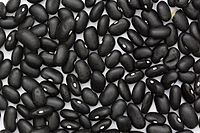Black turtle bean facts for kids
 |
|
| Nutritional value per 100 g (3.5 oz) | |
|---|---|
| Energy | 552 kJ (132 kcal) |
|
23.71
|
|
| Sugars | 0.32 |
| Dietary fiber | 8.7 |
|
0.54
|
|
| Saturated | 0.139 |
| Trans | 0 |
| Monounsaturated | 0.047 |
| Polyunsaturated | 0.231 |
|
Protein
|
8.86
|
| Vitamins | Quantity
%DV†
|
| Vitamin A equiv. |
0%
0 μg |
| Vitamin A | 6 IU |
| Thiamine (B1) |
21%
0.244 mg |
| Riboflavin (B2) |
5%
0.059 mg |
| Niacin (B3) |
3%
0.505 mg |
| Vitamin B6 |
5%
0.069 mg |
| Folate (B9) |
37%
149 μg |
| Vitamin B12 |
0%
0 μg |
| Vitamin C |
0%
0 mg |
| Vitamin D |
0%
0 μg |
| Vitamin E |
6%
0.87 mg |
| Vitamin K |
3%
3.3 μg |
| Minerals | Quantity
%DV†
|
| Calcium |
3%
27 mg |
| Iron |
16%
2.10 mg |
| Magnesium |
20%
70 mg |
| Phosphorus |
20%
140 mg |
| Potassium |
12%
355 mg |
| Sodium |
16%
237 mg |
| Zinc |
12%
1.12 mg |
| Other constituents | Quantity |
| Water | 65.74 g |
| †Percentages estimated using US recommendations for adults. | |
The black turtle bean is a small, shiny type of common bean. It's super popular in Latin American cuisine, which means it's eaten a lot in countries like Mexico, Brazil, and Cuba. You can also find it in Cajun cuisine and Louisiana Creole cuisine in the southern United States. Like all common beans, it first came from the Americas, but now people grow and eat it all over the world!
In Indian cuisine, especially Tamil cuisine, it's called karuppu kaaramani. In Maharashtrian cuisine, it's known as Kala Ghevada. People often just call it the black bean (frijoles negros in Spanish; feijão preto in Portuguese). But be careful, because there are other types of black beans too!
Contents
Why Black Beans Are Popular
Black beans have a thick, "meaty" texture. This makes them a great choice for vegetarian dishes. You might find them in Mexican-American black bean burritos. They are also a key ingredient in many famous dishes across Latin America.
Black Beans in Latin American Dishes
- In Brazil, black beans are very popular. They are used in the national dish, feijoada.
- In Cuba, they are a main part of Moros y Cristianos. This dish mixes black beans and rice.
- In Costa Rica and Nicaragua, black beans are a must-have for gallo pinto.
- In Venezuela, they are a basic part of Pabellón criollo.
- You'll find black beans served in almost all of Latin America. They are also popular in Hispanic communities in the United States.
- In the Dominican Republic cuisine, they use black beans for a dish similar to Moros y Cristianos, called Moro de habichuelas negras.
Black beans are also great in soups. In Cuba, black bean soup is a traditional meal. It's usually served with white rice.
History of Black Beans in the US
Black beans started to be widely grown in what is now the United States after the Mexican–American War (1846–1848). At first, they were mostly grown for their edible pods, like snap peas.
Using Black Bean Water
It's common to keep the water after boiling black beans. This water turns black and can be used as a soup. It's called sopa negra (black soup) or sopa de frijoles (bean soup). You can also use it as a broth (caldo de frijol) or to add flavor and color to other dishes, like gallo pinto.
Natural Colors in Black Beans
Scientists found in 2006 that black turtle beans have special natural colors called anthocyanins in their dried outer skins. These are the same kinds of colors found in blueberries!
Images for kids
See also
 In Spanish: Frijol negro para niños
In Spanish: Frijol negro para niños





